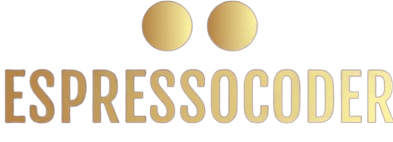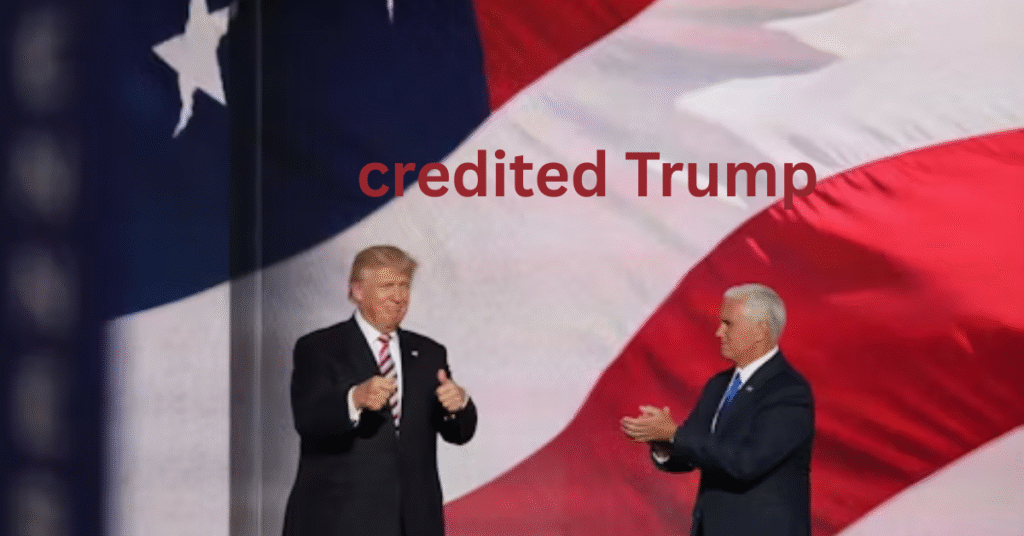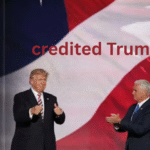In the realm of modern political discourse, few phrases carry as much weight or ambiguity as “credited Trump.” From economic growth to foreign policy achievements, infrastructure developments to pandemic responses, people across the the political spectrum often “credit Trump” with successes—or assign blame when outcomes sour. This article clarifies what “credited Trump” means, examines where such attributions are defensible or exaggerated, and provides an up-to-date, balanced overview of what Trump can legitimately be credited for—with reference to data, history, and credible analysis.
Within the first 100 words: when someone says “credited Trump,” they are asserting that a particular achievement or outcome is primarily due to former President Donald J. Trump’s actions, policies, or leadership. But attribution is rarely that simple. In this article, you will find a nuanced examination of what can be reasonably credited, where claims overreach, and how to assess such credit in a politically polarized environment.
Introduction: Attribution, Politics, and the “Credit” Game
In politics, taking credit is part of the narrative contest. Presidents, parties, and supporters habitually claim credit for favorable outcomes while shifting blame for missteps. Donald J. Trump, both as a candidate and as president (2017–2021), has been credited—and criticized—for a wide range of policy outcomes. But parsing which claims hold up under scrutiny and which are rhetorical or exaggerated requires careful examination of context, evidence, and competing influences.
This article proceeds in three parts: first, a framework for assessing when credit is legitimately due; second, a detailed survey of key domains often associated with Trump (economy, foreign policy, deregulation, judicial appointments, COVID-19 response, immigration, and more), assessing where credit is defensible; and finally, a set of guiding principles for readers to evaluate future “credited Trump” claims. A summary table will map domains to types of credit claims, and we wrap with five frequently asked questions.
Assessing Attribution: A Framework
Before diving into specific policy areas, it’s essential to lay out a principled framework for when credit (or blame) should be assigned:
- Causation versus correlation
Just because an economic indicator improved during someone’s tenure does not mean that person was the principal cause. Other global or structural factors may play dominant roles. - Pre-existing trends
Many policies or results may carry momentum from prior administrations. If a trend predates Trump’s presidency, assessing how much he accelerated or reversed it is key. - Shared responsibility
In modern governance, many actors—Congress, local governments, courts, private sector—play roles. A president’s credit should not overshadow the contribution of others. - Implementation and effect lag
Some policies take years to show outcomes, sometimes beyond a president’s term. Credit must consider delayed effects. - Intention versus outcome
Some policies are intended to produce certain outcomes but end up doing something else. If an outcome arises that the president did not intend (or even opposed), credit may be misplaced. - Transparency and scrutiny
Claims of credit should withstand data scrutiny, rival explanations, and critical analysis.
Using that framework, we now turn to domains where “credited Trump” claims are frequently made.
Domains Where Trump Is Often Credited (or Blamed)
Economy and Jobs
Claim: Trump revived the U.S. economy, created jobs, boosted growth.
Analysis:
- Preexisting growth and momentum
When Trump took office in January 2017, the U.S. economy was already in a decade-long expansion following the recovery from the 2008 financial crisis. Many indicators—unemployment, GDP growth, corporate profits—were on upward trajectories. - Tax Cuts and Jobs Act (2017)
Trump’s signature legislative achievement was a sweeping tax cut package. Proponents argue it stimulated investment, boosted wages, and grew employment. Critics argue the benefits skewed to corporations and higher-income individuals, while adding to deficits. - Regulatory relief
The Trump administration rolled back numerous federal regulations, particularly in energy, environment, and finance. Supporters credit this with spurring business activity; detractors warn of longer-term regulatory harms. - Short-term boost, long-term constraints
Some metrics improved early in his presidency—unemployment fell, consumer sentiment rose—but the COVID-19 shock in 2020 disrupted the upward trend dramatically. Much of the economic downturn then is widely blamed on the pandemic rather than solely on policy.
Verdict: Trump can be partially credited for providing a pro-business climate via tax reform and deregulation that may have aided short-run growth and job creation, but much of the momentum was inherited, and structural constraints (e.g., global trade, technological shifts) limited his influence.
Trade and Tariffs
Claim: Trump transformed U.S. trade policy, protecting American industries and reducing deficits.
Analysis:
- Tariff strategy
Trump imposed tariffs on Chinese imports, aluminum, steel, and goods from trading partners, asserting this would defend domestic industries. Some sectors responded with increased domestic investment; others faced retaliation, higher input costs, and supply chain disruption. - Trade deals renegotiated
He renegotiated NAFTA into the USMCA (United States–Mexico–Canada Agreement), often credited for modernizing trade rules and preserving access. He also reached a “phase one” trade deal with China in 2020, though many underlying issues remained unresolved. - Impact on deficits
U.S. trade deficits did not broadly collapse; in many cases, trade gaps persisted or worsened in certain sectors. Critics argue tariffs shift patterns rather than eliminate deficits. - Global positioning
His confrontational trade posture signaled a departure from traditional free-trade orthodoxy, which some credit with inducing strategic shifts in supply chains and alliances.
Verdict: Trump can be credited with shifting U.S. trade policy in a more protectionist direction, renegotiating major trade agreements, and forcing global attention to trade imbalances, though results were mixed and sometimes costly.
Deregulation and Administrative Policy
Claim: Trump eliminated or reduced unnecessary rules, unleashing private sector potential.
Analysis:
- Regulatory rollbacks
His administration eliminated many federal rules in environmental protection, banking, energy, and labor oversight. Supporters claim this lowered the compliance burden, especially for small and mid-sized businesses. - Cost-benefit scrutiny
Critics note many regulatory rollbacks had long-term environmental, health, or financial risks. Additionally, the benefits of deregulation are often diffuse or hard to measure, making attribution challenging. - Judicial and legislative challenges
Many rollbacks faced lawsuits or were reversed under subsequent administrations, which complicates long-term credit attribution.
Verdict: Trump can be credited with a decisive deregulatory agenda that removed or weakened numerous federal rules; the long-term effects remain contested and partially undone.
Judicial and Administrative Appointments
Claim: Trump transformed the judiciary for a generation.
Analysis:
- Supreme Court appointments
Over his term, Trump appointed three justices to the U.S. Supreme Court, reshaping its ideological balance. This is often seen as one of his most enduring legacies. - Federal appellate and district courts
He appointed a large number of conservative judges at lower levels, shifting jurisprudence in areas such as religious rights, business regulation, administrative law, and criminal justice. - Executive branch staffing
Many presidential administrations struggle to staff federal agencies quickly, but Trump filled a significant number of senior positions early. This staffing enabled earlier implementation of policies.
Verdict: Trump receives strong credit in this domain—his judicial appointments have already exerted tangible influence on American law and policy, and they are likely his most durable imprint.
Infrastructure, Domestic Projects, and Energy
Claim: Trump invested heavily in infrastructure and energy independence.
Analysis:
- Infrastructure ambitions vs. implementation
Trump repeatedly promised massive infrastructure spending. But while plans were floated, legislative and budgetary obstacles limited realization. Only modest infrastructure investments were achieved during his term. - Energy sector
Trump’s policies emphasized fossil fuel development—oil, natural gas, coal—and diminished emphasis on climate regulation. He withdrew the U.S. from the Paris climate accord, reduced restrictions on drilling and pipeline construction, and rolled back emissions rules. Supporters credit him with increased energy production and U.S. “energy independence.” Critics caution about environmental damage and long-term sustainability. - Rural and local projects
Some infrastructure and rural projects proceeded, but many local governments and states often drive or partner in those.
Verdict: Credit for infrastructure is limited—ambitions outpaced results. In energy, Trump can be credited (with caveats) for a short-run boost in fossil fuel production and regulatory loosening, but longer-term consequences and reversals are significant.
Immigration and Border Policy
Claim: Trump tightened U.S. borders, reduced illegal entry, and reshaped immigration policy.
Analysis:
- Border wall and enforcement
Trump significantly increased border fencing and deployed resources (e.g., more agents, surveillance). Some credit him with sharper deterrence; critics argue migration flows to major border crossings persisted via alternate routes. - Policy tools: “Remain in Mexico,” asylum rules, travel bans
He introduced the “Remain in Mexico” policy (Migrant Protection Protocols), restricted asylum options, and limited immigration from certain countries. These actions are cited as tangible shifts in policy. - Legal and humanitarian criticisms
Many of these policies faced legal challenges, public backlash, and logistical complexity. Also, measuring impact is difficult, given broader global migration pressure.
Verdict: Trump can legitimately be credited with stricter border enforcement and sweeping new rules on asylum and immigration. Whether those changes were wholly effective or morally justified remains debated.
Foreign Policy and National Security
Claim: Trump recalibrated America’s global posture, secured deals, and forced adversaries’ concessions.
Analysis:
- Middle East diplomacy
Trump brokered the Abraham Accords, normalizing relations between Israel and several Arab nations. Many view that as a significant diplomatic success. - North Korea and summit diplomacy
He engaged directly with North Korea’s leader, a move that broke diplomatic precedent. While major denuclearization did not materialize, the shift in tone was credited as bold. - Iran and sanctions
Trump withdrew from the Iran nuclear deal (JCPOA) and reinstated sanctions. Proponents credit this with pressuring Iran, though critics argue it increased tension and reduced enforcement leverage. - NATO and burden-sharing
He pressured NATO allies to boost defense spending, citing unfair burdens on the U.S. Some credit this with pushing increases; others say the pressure was already mounting. - China and strategic rivalry
Trump’s trade war, technology restrictions (e.g. Huawei), and tougher tone toward China are credited by supporters with initiating a new era of strategic competition.
Verdict: Trump can be credited with altering U.S. foreign policy direction in several theaters, especially the Middle East and China. Whether those changes proved beneficial or safe is more contested.
COVID-19 Response and Public Health
Claim: Trump handled the pandemic decisively and saved lives.
Analysis:
- Early responses and delays
The pandemic struck during Trump’s final year in office. Though he formed task forces, some critics argue he underplayed risks and missed opportunities to mobilize early containment. - Operation Warp Speed
A major success credited to Trump is the accelerated development of COVID-19 vaccines and therapeutics under Operation Warp Speed. Many agree that public-private coordination under that framework made vaccines available faster than usual. - Testing, supply chain, and messaging
His administration’s rollout of testing was criticized for initial shortages, logistical confusion, and inconsistent messaging. Mask guidance, school policy, and social distancing messaging were politically and scientifically contentious. - Vaccine distribution and uptake trends
Some vaccine rollout momentum occurred toward the end of his term, though much of the mass vaccination infrastructure matured after his departure.
Verdict: Trump can be credibly credited for pushing vaccine development faster than many anticipated. But credit is attenuated by criticisms of early pandemic missteps, mixed messaging, and reliance on the private and scientific community after his term.
Summary Table: Domains and Credit Assessment
| Domain | Claims Made | Level of Credible Credit | Key Caveats and Counterfactors |
|---|---|---|---|
| Economy & Jobs | Growth, job creation, wage gains | Partial – tax cuts & pro-business policies helped | Preexisting momentum, global trends, pandemic disruption |
| Trade & Tariffs | Protectionism, trade rebalancing | Moderate – trade deals and tariffs shifted posture | Retaliation, higher input costs, limited long-term gain |
| Deregulation & Admin Policy | Regulatory rollback, streamlined rules | Significant in removal efforts | Long-term harm, some reversals, tricky measurement |
| Judicial & Administrative Appointments | Courts, agencies repopulated with allies | Strong – lasting judicial impact | Role of Senate, confirmations process |
| Infrastructure & Energy | Infrastructure projects, energy output | Weak to moderate – fossil fuel growth | Infrastructure shortcomings, environmental cost |
| Immigration & Border | Border wall, asylum rules, deportation | Moderate – enforcement upgraded | Legal, moral, humanitarian tradeoffs |
| Foreign Policy & Security | Diplomatic deals, strategic posture | Moderate to strong in some arenas | Mixed outcomes, long-term effects uncertain |
| COVID-19 & Public Health | Vaccine push, pandemic management | Partial – vaccine acceleration credited | Missteps in early response, conflicting messaging |
Interpreting “Credited Trump” Responsibly
When people assert that something be “credited to Trump,” here are habits and questions worth applying:
- Ask for mechanism: How exactly did Trump’s policy produce the outcome? Vague claims like “he boosted growth” should be unpacked—through tax cuts, deregulation, spending, or other channels?
- Check timing and lag: Did the effect occur within his term, or much later, when external factors intervened?
- Look for counterfactuals: What would have happened without that policy? Could alternative policies or global events have produced the same result?
- Consider reversals: If successors reverse the policy easily, was the change that durable?
- Weigh who did the work: Recognize the roles of Congress, courts, states, private actors, and the economy.
If the claim passes those filters, then it is more defensible. Much of political discourse ignores such scrutiny, leading to overclaims of credit.
Fresh Updates and Recent Reappraisals (2024–2025 Lens)
Although Trump is no longer in office, the question of what to credit him continues to evolve in light of subsequent developments:
- Judicial legacy solidifies
As courts issue rulings that reflect originalist or conservative interpretations, the impact of Trump’s judicial appointments becomes more visible—on immigration, federal agency powers, and electoral regulations. - Tax and deficit pressures
The long-term effects of Trump-era tax cuts and spending patterns are now subject to federal deficit stress, debt ceiling debates, and calls to reverse or adjust tax provisions. - Renewed debates on trade and supply chains
The COVID shock and subsequent supply chain disruptions have led some analysts to credit Trump’s early warnings and tariff posture as prescient—even if contested. - Foreign policy continuity and reversal
Some later administrations have maintained or modified Trump-initiated policies (e.g. tensions with China, posture in Middle East), raising debates about how much Trump truly reset the baseline. - Climate and energy backlash
Many of Trump’s deregulation efforts in energy have been rolled back or challenged by courts and subsequent administrations, complicating claims of enduring credit. - Historical reassessment
Historians and policy scholars are increasingly refining their assessments—some augmenting credit for bold risk-taking, others emphasizing costs and missed opportunity. The academic literature is more critical, but nuance is emerging.
Thus, as we stand in 2025, the landscape of what we credit Trump is sharpened by additional evidence, reversals, and long-term outcomes.
Limitations of Overcrediting: The Risks
Over-attribution to a single figure like Trump (or any political leader) poses several risks:
- Encourages oversimplification
Complex systems—economics, diplomacy, immigration—don’t reduce neatly to individuals. Overcredit exaggeration flattens nuance. - Undermines accountability
If credit is overused, blame becomes blurred, and responsibility for failures is diffused. - Fuel for polarization
Claiming all credit for successes becomes a political tool to marginalize opponents, rather than fostering healthy debate. - Deters critical thinking
Readers may take credit claims at face value rather than probing evidence and mechanisms.
Thus a measured approach to “credited Trump” is healthier for public discourse.
How to Use This Article as a Reader
- Use the framework in Assessing Attribution when you see headlines claiming “Trump gets credit for X.”
- Refer to the Summary Table when evaluating domain-specific claims.
- Revisit the Recent Reappraisals section to see how time and new evidence adjust what credit seems defensible.
FAQs
1. What is meant by “credited Trump”?
“Credited Trump” refers to the attribution or recognition that a specific result—say, economic growth, judicial realignment, or foreign policy success—is primarily due to Donald Trump’s actions, decisions, or leadership. The phrase often appears in political discussion when supporters or commentators ascribe positive outcomes to his tenure. In practice, such credit must survive scrutiny of causation, context, trend, counterfactuals, and shared responsibility.
2. Can Trump legitimately be credited with job growth?
Partially. While unemployment dropped and labor force figures improved during his term, much of the momentum was inherited from prior administrations. Trump’s tax cuts, deregulation, and business climate may have contributed—but external factors, global trends, and private sector inertia also played large roles. Thus job growth cannot be wholly attributed to Trump alone.
3. Did Trump merit credit for vaccine development during COVID-19?
Yes—to a limited degree. Operation Warp Speed—a public-private acceleration program initiated during his administration—helped speed development of COVID-19 vaccines. But credit is shared: scientific institutions, pharmaceutical companies, regulatory flexibility, and subsequent administrations’ distribution efforts all contributed. Also, early missteps and messaging issues limit the scope of full credit.
4. Is Trump’s judicial legacy the most defensible credit?
Arguably yes. His appointments to the Supreme Court and lower federal courts reshaped judicial ideology in lasting ways. Many major court decisions now reflect the influence of those judges. Because the judiciary is harder to reverse quickly, this may be the longest-lived domain in which Trump’s credit claims are hardest to dispute.
5. How should a reader decide whether a claim “credited Trump for X” is real or exaggerated?
Use a skeptical but fair lens: ask for detailed mechanisms, check timing and preexisting trends, look at contributions by others (Congress, courts, states), consider reversals, and weigh alternative explanations. If the claim is vague, lacks evidence, or ignores complexity, it is likely exaggerated. If the claim can explain how policy translated into measurable outcome and withstand counterarguments, it is more defensible.
Conclusion
“Credited Trump” is more than a phrase—it reflects a battle over narrative, legacy, and public memory. While Donald Trump’s presidency included bold initiatives, sweeping regulatory changes, and a lasting judicial imprint, attributing every favorable change to him alone oversimplifies complex systems. This article has provided a structured framework for assessing credit claims, domain-specific analysis, up-to-date reappraisals, and cautionary guidance. As observers, scholars, and citizens, our task is to parse rhetoric from reason, giving credit where warranted, while maintaining intellectual honesty and nuance.







